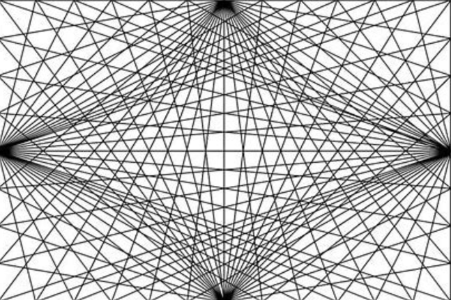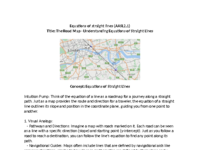Equations of straight lines (AASL2.1)

Keywords
| English | Japanese | Korean | Chinese Simplified |
| Standard Equation of a Line | 直線の標準方程式 | 직선의 표준 방정식 | 直线的标准方程 |
| Parallel Lines | 平行線 | 평행선 | 平行线 |
| Perpendicular Lines | 垂直線 | 수직선 | 垂直线 |
| Slope | 傾き | 기울기 | 斜率 |
| Parallelism | 平行性 | 평행성 | 平行性 |
| Perpendicularity | 垂直性 | 수직성 | 垂直性 |
| Slope-intercept Form | 傾き-切片形式 | 기울기-절편 형식 | 斜截式 |
| y-intercept | y切片 | y-절편 | y轴截距 |
| Coefficients | 係数 | 계수 | 系数 |
| General Form Equation | 一般形式方程式 | 일반 형식 방정식 | 一般形式方程 |
| Line Steepness | 線の急斜度 | 선의 가파름 | 线的陡峭度 |
| Horizontal Lines | 水平線 | 수평선 | 水平线 |
| Vertical Lines | 垂直線 | 수직선 | 垂直线 |
| Perpendicular Slope | 垂直線の傾き | 수직선의 기울기 | 垂直斜率 |
Inquiry questions
| Factual Inquiry Questions | Conceptual Inquiry Questions | Debatable Inquiry Questions |
| What is the standard form of the equation of a straight line? | Why does the slope play a crucial role in determining the parallelism or perpendicularity of two lines? | Is the concept of parallel and perpendicular lines more significant in geometry than in practical applications, or vice versa? |
| How can you determine if two lines are parallel or perpendicular based on their equations? | How can the equations of parallel and perpendicular lines be derived from a given line equation? | Can the mathematical principles of parallel and perpendicular lines be applied to conceptualize ideas in modern physics and cosmology? |
| How do the concepts of parallelism and perpendicularity in straight lines influence architectural design and urban planning? |

Exploring the Slope (m) Move point A vertically up and down. How does this affect the slope (m) of the line? Does the slope increase or decrease as you move A up or down? Move point B horizontally left and right. How does this movement change the slope? What happens to the slope if B moves further away from the y-axis?
Intercept (c) Exploration Keep the slope constant and move point A horizontally left and right. How does this affect the y-intercept (c)? Does the intercept increase or decrease as A moves? What happens to the y-intercept if you keep point A fixed at the y-axis and only move point B along the line?
Exploring Slopes of Parallel Lines Adjust point A along the red line and point C along the blue line. Observe how the slopes of both lines remain constant despite the movement of these points. What does this tell you about the slopes of parallel lines? How do the equations of the red and blue lines change as you move points A and C? What remains constant, and what can change while maintaining parallelism?
Understanding Y-Intercepts of Parallel Lines Move point B vertically. Note how the y-intercept of the red line changes. Can you move point B to make the two lines intersect, or do they remain parallel regardless of the y-intercept? Examine the relationship between the y-intercepts of the two lines. When the slopes are the same, how do different y-intercepts affect the distance between the two lines?
Horizontal Lines Investigation Can you manipulate points A, B, and C to create horizontal lines? What would the slope of a horizontal line be, and how would you represent it in slope-intercept form? If you have two horizontal lines, what must be true about their y-intercepts if they are to remain parallel?
Effects on the General Form Coefficients (a, b, and c) As you move point A, observe how coefficients 'a' and 'b' in the general form change. Is there a consistent pattern between the changes in 'a' and 'b' and the movements of A? Move point B while keeping A stationary. How do the coefficients 'a', 'b', and 'c' change? Can you establish a relationship between these changes and the position of B?
The General Form - ax+by+c - Puzzle
Part 3 - Perpendicular lines
Investigating Slope Ratios
Change the gradient of one line using the slider. What happens to the gradient of the perpendicular line? How does the ratio between the two gradients change?
Exploring Slope Signs Observe the signs of the gradients as you adjust the slider. If one line has a positive gradient, what can you infer about the gradient of the perpendicular line?
Slider Position and Line Steepness As you move the slider from one end to the other, note the steepness of each line. How does the steepness of one line relate to the steepness of the line perpendicular to it?
Try to create a horizontal line. What is the slope of the perpendicular line? Similarly, try to adjust the slider to create a vertical line. What do you observe about the slope of the line perpendicular to it?
Checking your understanding
1. What is the slope of a line parallel to the line \(y = 3x + 7\)?
2. If two lines are perpendicular to each other and one has a slope of 4, what is the slope of the other line?
3. What is the equation of a line that passes through the points and ?
4. A line passes through the point (5, 2) and is perpendicular to the line \(y = -\frac{1}{2}x + 3\). What is the equation of this line?
5. If a line is parallel to \(\) and passes through the point , what is its equation?
6. What is the slope-intercept form of the equation of the line that is perpendicular to \(x - 2y = 6\) and passes through the point (3, -1)?
7. The equation of a line that is parallel to the x-axis and passes through the point is:
8. A line has an equation . What is the slope of a line perpendicular to this line?
9. What is the equation of the line that passes through the point and has the same slope as the line ?
10. The equation of a line that is perpendicular to the line \(\) and passes through the point is:
![[MAA 2.1] LINES.pdf](https://www.geogebra.org/resource/njez9a9k/AYjv0M0xd3xJvq4f/material-njez9a9k-thumb.png)
![[MAA 2.1] LINES_solutions.pdf](https://www.geogebra.org/resource/fe9nqr7w/atc9lh3UxSGjkLAC/material-fe9nqr7w-thumb.png)

